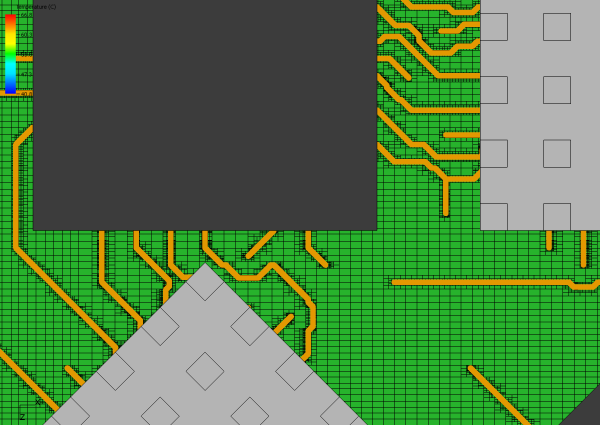BY TOM GREGORY, product specialist,
6SigmaET,
Thermal behavior at the component, board and system level is becoming increasingly important in electronics design. While systems are becoming more energy efficient, there is still the requirement to cram ever-increasing amounts of electronic circuitry and functionality into ever-smaller footprints on a printed circuit board, potentially giving rise to a significant build-up of heat.
This condition is applicable to numerous applications such as in mobile devices, where processors can heat up by more than 30°C within a matter of seconds when handling highly computationally intense workloads. Any design needs to manage sharp heat rises to protect components and distribute heat effectively and efficiently across the system, while also ensuring that it does not become uncomfortably hot – which is especially important in the case of a handheld device. And in the automotive industry, excess heat can reduce reliability, possibly even leading to vehicle recalls and a great deal of expense. HEVs (Hybrid and Electric Vehicles) are a prime example of a system that requires high-density power electronics and a major challenge is the effective removal of generated heat, especially considering that power devices can dissipate tens or even hundreds of watts of waste heat.
Simulation
A key tool that helps map the thermal behavior of a system is simulation. Thermal simulation is essentially a specialization of the technology developed for computational fluid dynamics (CFD), which uses the Navier-Stokes flow equations for viscous and heat-conducting fluids to model the flow of fluids through and around objects. It has been an important part of the design process of electronic equipment for the past 25 years and aids engineers in the verification and optimization of thermal design. For instance, a better understanding of the heat distribution through a system can be used to fine-tune a design.
A key element in simulation is the generation of a grid to represent a system as a mesh of cells. While there are many different methods of generating a suitable grid, quality is crucial to achieving an accurate solution. There is a trade-off between compute performance and grid detail: one that is too finely detailed will take significantly longer to calculate, and may not even fit into the computer’s memory. Conversely, if the grid is simplified to use a more coarse-grained structure, there can be a significant impact on the accuracy of the simulation. In practice, engineers will alter the resolution of the grid to focus on those parts of the design that are thought to be thermally significant. But this fine-tuning has traditionally required manual intervention, which is a time consuming and complex process.
Thermal modeling software
6SigmaET is a thermal modeling tool specifically designed for the electronics industry and has delivered significant improvements to simulation modeling techniques and efficiency over many years. The latest version (Release 9) of the tool incorporates object-based gridding with predefined rules that automatically decide the best grid for the simulation. The tool’s multi-level unstructured staggered grid solver provides a novel way to efficiently solve the Navier-Stokes equations at the heart of CFD and relieves the burden of having to manually optimize the grid.
Starting with a fine grid over the whole model, a hierarchy of increasingly coarse Cartesian grids is constructed and the solver selects from these only those cells necessary to resolve the geometry. This ensures that large areas that do not need highly detailed grids are treated at a suitable level of resolution, but still allow the selection of a finer grid for smaller objects. Unlike many of the unstructured solvers currently available, the 6SigmaET solver retains the simplicity of staggered grids to avoid some of damaging interpolation that is usually required. In the example model of a PCB shown in Figure 1, resolving all the copper traces would have required nearly one billion cells.

Fig. 1: 6SigmaET can achieve a solution within minutes to resolve all the copper traces in a typical PCB layout
However, the 6SigmaET solver in Release 9 requires only six million cells to achieve the same level of resolution, achieving a solution in minutes. In fact, a ten-fold reduction in solve time has been demonstrated for many designs. Additionally, the 6SigmaET solver takes advantage of parallelized multicore technology and is capable of solving models in excess of 300 million grid cells and has shown it can reduce solve times by more than 70 percent in comparison with traditional single-core thermal simulation tools.
6SigmaET Release 9 also has a number of user-interface and functionality enhancements that have made it easier to create a thermal model using intelligent objects, PCB and CAD data. Import functions also allow the use of the output from EDA tools using the IDF, IDX, XFL and Gerber file formats. Some thermal simulation environments demand that commonly used and thermally important components such as heatsinks be modeled as a complex collection of cuboid objects, ones that often need to be generated by hand. 6SigmaET can use intelligent objects to represent these components in a manner that is much faster and easier to use.
Advantages
In summary, a key advantage of 6SigmaET thermal simulation software is the employment of a high level of automation and intelligence. This makes it usable by a broad community of engineers and not just specialists in thermal simulation. In addition, the use of simulation can enable significant cost savings and return-on-investment for OEMs. Its use can reduce project delays or negate the need to redesign product enclosures and PCBs, or very importantly help to avoid product recalls if thermal problems are discovered following market deployment. And it could make all the difference in ensuring a product is released on time and does not miss out on an important market opportunity. However, not all thermal simulation tools were born equal and understanding the benefits and trade-offs of thermal simulation technology are key to making the right purchasing decision.
Advertisement





